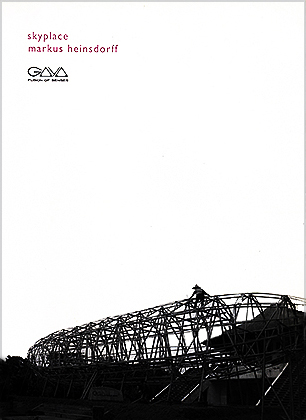skyplace - markus heinsdorff
A Zeppelin made of bamboo by local craftsmen propped up over a surface of water on the island of Bali. Markus Heinsdorff has brought just such an artistic entity into existence - and although it may be devoid of any practical utility, it functions on a number of levels as a piece of utopia. It is precisely this, the incongruity of form and function and the apparent contradiction between European and Asian associations and perceptions, which transform the installation Skyplace into a poetic monument of global import.
The airships built in Germany in the first part of the 20th century were considered peaceful, if not clumsy giants of the airways. The fascination supporting the myth of these airborne cigars has scarcely waned, even to the present day. The abrupt decline of the Zeppelin era after the horrifying Lakehurst disaster was not enough to stifle the dream of these elephants of the skies.
Markus Heinsdorff has created a motionless airship that breathes new life into the memory of these soft-metallic bodies, yet he does so with bamboo - one of nature's ready-made gifts; and he employs time-honoured craftsmanship that has developed in conjunction with the millennia-long use of this building material in the East.
Heinsdorff's first drafts for a bamboo creation were of a large sphere that could be entered by the visitor. It was his intent to show that even the most quintessential, stereometric shapes could be built using naturally grown building materials with almost child-like ease, merging a typical occidental ideal with the improvisational freedom of traditional Torajan and Balinese building techniques.
The 27 metre long, 5.5 metre high airship, Skyplace, is a modification of this dream. Its elongated aerodynamic shape emerges organically from the material and its 18 slender trusses, resembling the legs of a centipede, give an element of movement to Heinsdorff's recumbent, ideal construction.
The hexagonal figures made of bamboo canes do not merely function as outer elements of the structure, rather their inner girth creates the hollow framework of the body and their upright, row-upon-row placement aligns to form a tunnel-like perspective through which the impression of an easeful cylindrical form is created.
The vessel is held aloft by gently slanting trusses that poke downward through its body into the water below, and extend upward into the vessel's innards to form nine steeply merging apexes. The vessel's intricate framework narrows at both ends, terminating like two opposing points in the orbit of a celestial body. A visitor's footbridge hangs through the centre of the upward-tapering triangular supports. Every structural element has been joined together using the methods of thousand year old Torajan bamboo craftsmanship.
This fully transparent, breeze-swept structure embodies the word 'airship.' Most certainly, every observer is aware that this object cannot actually fly - nor has it any desire to; yet, one feels that it would be but a small feat for this filigree structure to rise up into the air or to set off on wheels. The fact that this flying object can be taken down and then reassembled in a different location in matter of hours adds another aspect to the notion of virtual mobility.
Similar to Graf Zeppelins explicit archetypal vision of a rigid airship at the dawn of the mobilisation of the skies, the artwork, Skyplace, has become an image-laden symbol for the dream of rising up over the earth without a hint of exertion, a dream of floating off in motion. The mechanised version of his dream came to a fiery end in 1937 and it was many decades before the old utopia could be replaced with new content. The handcrafted materialisation of this symbol, which Heinsdorff initiated, using one of nature's own products, shall in some sense physically revive Icarus' ancient ethereal dream of flight.
Slender canes that forge its corporeal being define the near sketch-like, cylindrical existence of this vessel over the water. Whoever enters will certainly be struck by an intense feeling of freedom when gazing through the broad openings between the canes out upon the countryside, up toward the sky and down below upon the water, which in turn will reflect the sky above and create a twinned image of the bamboo construction. Faintness and a feeling of vertigo accompany the delusion of flight that is wrought by being made to feel as though one has been held suspended, floating in the unknown.
Visitors to Skyplace will get an idea of the breathtaking feeling of drifting that passengers aboard the large luxury Zeppelins must have had when they looked out through the tilted panorama windows down upon the earth and sea below.
Heinsdorff's bamboo framework, hovering over a flooded rice field built into the front lawn of the leading art gallery in Bali, is much more than a European's artistic homage to the great cultural traditions of Asia; it's the visual materialisation of an ancient human desire brought into existence by means of Asian craftsmanship. It forms a binding link between Count Zeppelin, Dedalus and Icarus, and it unites both the ages and the continents.
But in spite of every interpretation that can be read into an object the shape of a cigar, Skyplace, with its elegant, water and wind-swept body, its slipstream inner perspective, its succession of interconnected triangular and hexagonal forms, its illusionary tapering rings that end in vanishing points: is a creation of the utmost suggestion, a pipe dream come true, a three dimensional blueprint at a scale of 1:1, a piece of transparent architecture that communicates a physical sensation of the imponderability of open space.
Wolfgang Wall
Art historian, working as freelance journalist, Munich
